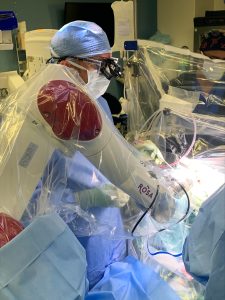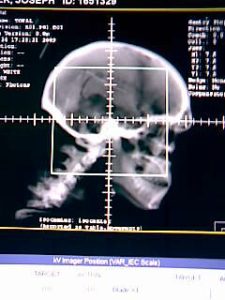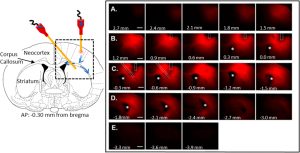Key Technologies
- Stereotactic and Functional Neurosurgery
- Peripheral Nerve Interfaces
- Electrokinetic Convection-Enhanced Drug Delivery to the Brain
- Robot-Assisted Deep Brain Stimulation
- Brain-Computer Interfaces and Extended-Reality implementations


Stereotactic and Functional Neurosurgery
Gamma Knife surgery represents one of the most advanced and precise means available to manage brain tumors and metastases, arteriovenous malformations, and pain or movement disorders. Requiring no surgical incision to treat the target, the Gamma Knife is one of the primary means of delivering focused radiation called stereotactic radiosurgery.
Houston Methodist Hospital houses the newest Leksell Gamma Knife system, the ICON. This system uses an internal collimator system with 4, 8, or 16 mm isocenters and 192 Cobalt 60 sources for radiation.
Peripheral Nerve Interventions
Issues with peripheral nerves, including entrapment or compression, can result in significant pain or disability. Many patients often see a spine surgeon, or even undergo a spine surgery, without recognizing it may be their peripheral nerves in the arms or legs that are triggering pain or weakness! An experienced neurosurgeon is able to triage and discern what the source of a patient’s disability may be from.
Interventions: Peripheral Nerve Decompressions, Peripheral Nerve Repairs, Peripheral Nerve Transfers, Peripheral Nerve Tumors, Targeted Muscle Reinnervation (TMR), Mechanomyography (MMG), Electromyography & Nerve Conduction


Electrokinetic Convection-Enhanced Drug Delivery to the Brain
Electrokinetic convection enhanced delivery (ECED) has the potential to deliver drugs and other bioactive substances to local regions in the brain with improved control and lower applied pressures than pressure-based Convection enhanced delivery. We investigate key biophysical properties of molecular transport in the extracellular space of the brain that may impact the efficacy and control of drug delivery using stereotactic methods. Understanding these principles is critical for further refinement of predictive models that can inform advances in stereotactic techniques for convection-enhanced delivery of therapeutic agents to the brain.
Robot-Assisted Deep Brain Stimulations
Robotic-assisted stereotaxy has been increasingly adopted for lead implantation in stereoelectroencephalography based on its efficiency, accuracy, and precision. Despite initially being developed for use in deep brain stimulation (DBS) surgery, adoption for this indication has not been widespread.
Robotic-assisted DBS surgery increases precision and reduces the potential for human error associated with traditional frame-based surgery, in which several settings must be changed manually and multiple times. With robot-assisted surgery, we demonstrate improvement in lead placement error corresponded with accumulated experience using the ROSA system (Medtech, Zimmer Biomet). Additionally, we demonstrate good lead placement accuracy, and characterize learning curves.

Brain-Computer Interfaces and Extended-Reality implementations
Neural engineering has seen great advancements in recent years, with processing power, signal fidelity, number of recording channels and diversity in modalities of wearable healthcare devices. These tools have generated enormous amounts of data. Combining these interface capabilities with advances in machine learning tools and data processing methodologies, in a symbiotic research program with neuro surgeons, engineers, and data scientists, together with virtual and augmented reality, we aim to develop multiparametric brain-computer interface enhancements. These extensions of current technology include: feedback capabilities in extended reality systems, explainable machine learning, adaptive neural interfaces, and automatic physiological biomarker feature identification for data-driven brain-computer interface technology.
